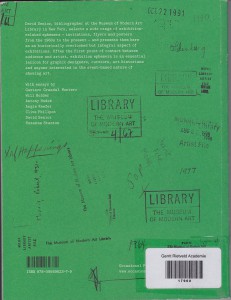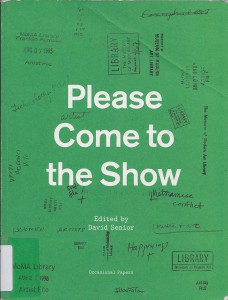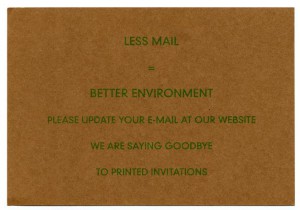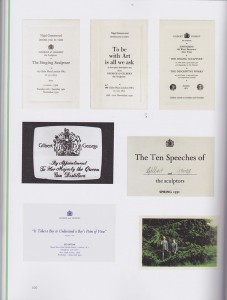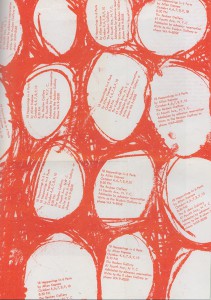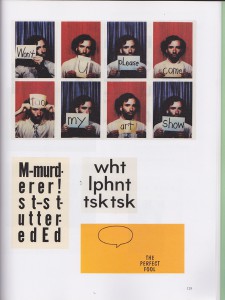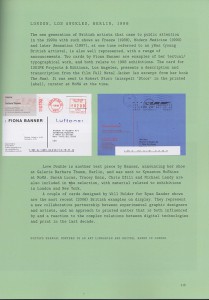Please come to the show : the title is calling your attention.
HAVE A LOOK AT THE BOOK ( clic on : look inside )
«I’m inviting you to see my work.»
By that invitation, an artist is offering you a dialogue, a direct form of exchange. It’s becoming personnal, between the two of you. As if you were starting a conversation at this very moment and that will be continued at the exhibition.
Sending. Receiving. Answering ?
Artist. Postal service bridge. Audience.
A first visual step before you see the works, something to give you the curiosity to want to encounter it. By this piece of paper, an interaction is created. The showing process is a way of meeting and making a message resonating through people.
Please come to the show’; what a calling, yes of course I will.
If the show is in that book, yes of course I will open it.
Because this is what it is all about in here : an archive of exhibition-related ephemera, which means ‘all the printed productions that go along with exhibiting’. All that pages are a tribute to the museum’s memory, an exploration of the ways of inviting people to experience art from the early 1960s to today. As an archaeologist, you dig into the stratified sampling of cultural communication.
Ephemera production relate to a specific time lapse : it gives a physical form to a moment. A moment that is coming or that is already passed. That direct way of seeing the setting and spirit of artist’s practices illustrate range diverse artistic activities. It makes a connection between the artworks and the viewing of it. As a window it enhances it, it disguises it or it gives a really good and simple viewing of it. It is at the same time an experience of the artworks just as much as the art piece in itself.
The information’s display builds a context, a fantasy of the event. The main goal is to attract people, to fan the flame of their curiosity. We are talking about a place, a day ; the basic information that an invitation gives. Then the display of the words, the image, the size, the paper are adding a specific aspect to the message. Making it unique and appealing .
All this invitation production can be affiliate to the postal art way of thinking. What can you send by post? Basically everything if it is stamped enough and the receiver’s address is readable. The possibilities are rich and various. It is a way to make ideas travel and thoughts physical. The communication is becoming visible, translated in an object. I’m nostalgic for that thing that we almost never experience : receive an invitation card by post or from someone . It looks much more personal than the new trend of mail-invitations or Facebook yes/like-it/no, I’m coming. My letter box stays frighteningly empty with that surge of creativity.
« The show looked back at the genre of the printed invitation in the midst of this technological watershed point – which has made it really hard to remember how people communicated in the not-so-distant past.
During the last five years or so (or maybe it has been a decade?) it’s a regular occurrence to get notices from galleries or institutions announcing the end of their program of printing invitations.
The example above comes from Brazil – a gallery named Galeria Fortes Vilaca. It has stayed on my desk for a couple of years as a particularly handsome example of the genre. In hindsight, I wish I did a better job at collecting more of these announcements.»
David Senior MOMA bibliographer and editor of the book
If it’s important to collect and record this kind of production to keep trace of the artistic evolution, it has to become interactive. That is the goal of making a book : let the people use the archive in an active way.
In a formal way the book is an example of how to present an archive in such a way to put emphasis on their impacts, influences and the way they are interconnect. The display is giving an other layer or makes easy the analysis of the collection process.
As the book is a collection of communication medium it’s full of type, there is a lot to see and to read in the images but every thing is breathing on the white background. And there is no text to guide the images, which are free to express themselves. If you need to know more, all details are indexed at the end. No information overdose.
Every page is different; sometimes one image occupies a full page, then there are five images on the same. They are talking to each other, getting into some friction. The eye is jumping from one to another, navigating in the words flow.
Comparing, gathering, opposing.
You will come across some famous names of Arts History, making them close and alive. Connecting your art theory book knowledge with some other people real life memories.
In between some green interlude with food for the mind, text becomes more theoretical thoughts about the exhibition, focusing on particular examples and anecdotes about the theme. It enhances some specifics angles of the example and gives various tracks to look at it.
Looking, breathing, thinking.
Texte / image / image / image / image / image / image / image / image/ image / image / image / image / Texte / image / image / image / image / image / image / image / image/ image / image / image / image / / Texte / image / image / image / image / image / image / image / image/ image / image / image / image / Texte.
The graphic design of the book is looking for balance in the elements.
Make it simple, legible but not boring.
This book please to the show is part of Sara de Bondt and Anthony Hudek imprint Occasional Papers. A non profit publisher that is developing a collection of affordable publications focusing on various cultural research subject.
Make the reflexion accessible in the understanding and in the object.
In her works she talks of deconstruction, using and transforming the basics rules of graphic design. She is also talking about the uniqueness of a piece and the correlation between the context and the design.
A book about communicative printed objects are a poetic way of looking at history. It is an alternative way to think about what happens in arts. As someone who is working in the art field, ‘Please Come to the Show‘ is opening reflections on how you are sharing your works, the multiplicity of communication possibilities that are accompanying an exhibition .
Rietveld library catalog no : 700.4 sen1
